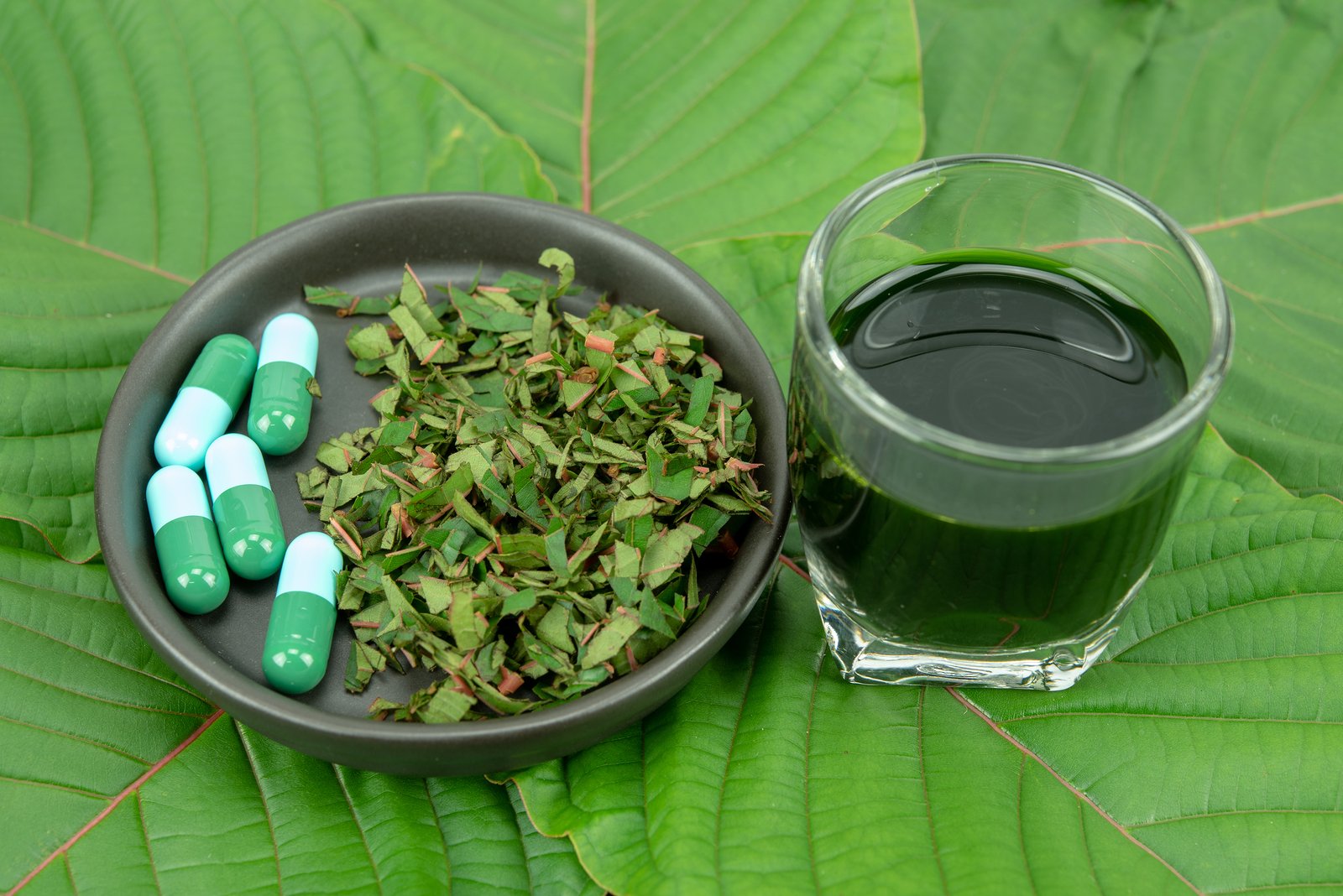Last Updated: August 17, 2022
Kratom is a tropical tree that has a long history of traditional and ceremonial uses in Africa and Southeast Asia. It is also known as: Biak, Ketum, Kakuam, Ithang, Thom, Herbal, and Ketum. Kratom looks like fresh or dried leaves and can be made into a green powder, liquid extract, gum, or pill. Nowadays people chew kratom leaves, brew the dried or powdered leaves as tea, eat them in food, or smoke them. Traditionally in Africa and Southeast Asia kratom’s leaves are chewed or consumed as a powder to help reduce fatigue, in particular by seamen and manual laborers on rubber plantations, and also culturally by individuals whose religious practices prohibit alcohol consumption.
A member of the coffee family, kratom has long been used to relieve pain and ease opiate withdrawal in parts of Asia. It is available in many forms, including dried/crushed leaves, powder, capsules, tablets, liquids, and gum/resin; the most common route of administration is ingestion as a brewed tea, although smoking, chewing the raw leaves, and the ingestion of extracts have also been reported. The substance has become an increasingly popular alternative therapy and is readily available on the recreational drug market.

Is Kratom legal?
According to FDA research, kratom is an agonist that binds to mu-opioid receptors in the brain. These are the same receptors that are activated when you take opioids, like prescription painkillers or heroin.
Kratom is, essentially, a natural opioid. Like all opioids, it comes with a risk of tolerance, dependence, and withdrawal.
It’s thought that mitragynine and 7-hydroxymitragynine may help control pain by attaching to these opioid receptors, which, in turn, reduce pain perception.
Kratom has gained popularity as an alternative to opioid pain medications like Vicodin (hydrocodone) and OxyContin (oxycodone). In many cases, kratom is used to manage chronic pain associated with conditions such as arthritis and fibromyalgia.
Kratom Is Legal In The USA, But…
In 2016 DEA (Drug Enforcement Administration) announced its intent to temporarily place mitragynine and 7-HMG into Schedule I “to avoid an imminent hazard to public safety.” Prior to this announcement, kratom was regulated as an herbal product under FDA and DEA policies and, as such, was considered to be a legal substance in most of the U.S. Placing a drug into Schedule I means that in the DEA’s view, the drug has “no currently accepted medical use and a high potential for abuse.” Emergency-scheduling is usually for a period of 2 years (with a 1-year extension available) while the DEA gathers additional information, after which a more permanent classification may be implemented using the formal administrative rulemaking process. Emergency scheduling is only for a Schedule I drug.
In 2018, the website STAT reported that the Department of Health and Human Services had recommended a ban on the chemicals found in kratom.
As of 2020, federal regulation remains on hold as the debate over the substance continues. The FDA has issued warnings to companies that sell kratom in the U.S. and illegally market the drug as an herbal supplement to treat addiction, anxiety, pain, and other health issues. Only FDA-approved drugs can make such claims. The future legal status of the drug remains to be seen, but legally in the USA kratom is considered to have “no currently accepted medical use and a high potential for abuse.”
Common Side Effects
Although case reports have reported drowsiness, irritability, palpitations, high blood pressure, poor concentration, insomnia, hypothyroidism, seizures, psychosis, hepatitis, and coma in people using kratom, it’s unclear how much is directly attributable to kratom.
Risks appear to be higher when it’s taken in concentrated extracts (which have a higher potency), mixed with other psychoactive substances, drugs, or adulterants, or when it’s taken by people with alcohol use disorders, a history of heroin use, or certain health conditions.
Potential health effects include:
- Anorexia
- Calmness
- Constipation
- Discoloration of the cheeks
- Dry mouth
- Euphoria
- Increased social behavior
- Increased urination
- Insomnia
- Itching
- Loss of appetite
- Nausea
- Psychotic symptoms (hallucinations, delusion, confusion)
- Sensitivity to sunburn
- Sweating
- Talkativeness
According to reports by U.S. poison control hotlines, calls involving kratom overdoses rose 50-fold from 2011 to 2016. In most cases, the kratom was laced with other drugs. If you or someone you love are experiencing any signs of overdose, call 911 or the Poison Control helpline (800-222-1222) immediately.
Kratom Withdrawal
If someone you love is using kratom, it’s important to be on the lookout for the common side effects (such as talkativeness, increased social behavior, itching, changes in appetite, sweating) as well as any unusual or extreme shifts in mood, behavior, appearance, and overall health. Kratom comes with a risk of tolerance, dependence, and withdrawal. Kratom users can build tolerance, or needing more to achieve the desired effect, and experience symptoms of withdrawal when they stop taking the drug.
How Long Does Kratom Stay in Your System?
More research is needed to determine the exact half-life of kratom. Like other substances, how long kratom stays in your system will depend on the following factors:
- Age
- Body fat
- Frequency of use
- Genetics
- Metabolic rate
- Type of kratom
- Water and food intake
Kratom’s main active alkaloid, mitragynine, can be detected in a urine test.
Addiction
The DEA states that kratom abuse can lead to addiction and can result in psychotic symptoms, including hallucinations, delusion, and confusion.
Not everyone will experience addiction in the same way, but there are several hallmark signs and symptoms, including tolerance, dependence, and withdrawal. Other common signs of kratom addiction include:
- Changes in friends
- Changes in mood, sleeping patterns, weight, and activity levels
- Financial trouble
- Loss of interest in hobbies, social activities, or job or school
- Secretiveness, stealing, and/or lying
- Keeping stashes of drugs or paraphernalia
- Trouble scaling back or stopping drug
- Spending vast amounts of time spent getting, using, and recovering from the drug
Withdrawal
People who take large doses of kratom several times per day have an increased risk of moderate to severe withdrawal symptoms. In general, however, withdrawal symptoms are milder in comparison to opioid withdrawal and may include:
- Decreased appetite
- Diarrhea
- Difficulty sleeping
- Fever
- Hot flashes
- Increased muscle spasms and pain
- Mood disturbances
- Runny nose
- Watery eyes
What is Kratom Tea?
What is kratom tea?
Kratom tea is traditionally made by brewing leaves from the kratom tree. Traditionally, field workers would chew on kratom leaves to help increase their energy and endurance, aid their heat tolerance, and relieve fatigue. These leaves were also used as an herbal remedy to treat various illnesses, including coughing, diarrhea, diabetes, and high blood pressure. They were likewise used as a substitute for opium — a potent pain reliever — or for opium withdrawal.
Kratom leaves that are used to make kratom tea contain more than 40 active compounds, although the main ones are mitragynine and 7-Hydroxymitragynine. These compounds act upon various receptors in the brain, causing effects similar to those of stimulants and opioid pain relievers, depending on the dosage.
In small doses between 1–5 grams, kratom acts as a stimulant and appears to increase energy, causing people to feel more alert and social.
In higher doses between 5–15 grams, kratom appears to have a sedative effect, similar to that of opioid pain relievers, such as morphine and codeine, causing people to feel tired, calm, and euphoric.
The higher dosage range is traditionally used to treat conditions like diarrhea and cough. It’s likewise used to treat opioid withdrawal symptoms.
In very high doses above 15 grams, kratom’s sedative effects are much higher and may cause people to lose consciousness.
Kratom leaves from different parts of Southeast Asia have varying levels of mitragynine. Malaysian kratom leaves have a much lower concentration at 12%, compared with 66% for Thai kratom leaves.

What is Kratom CBD?
CBD Kratom is one of the largest companies, which offers a selection of CBD and Kratom products. CBD Kratom products are grown organically in Colorado and Oregon and our Kratom is sourced from Southeast Asia. They carry everything from CBD oils and bath products to over 50 strains of Kratom. We guarantee that no matter your needs, we have the right products to help. Their online shop sells Kratom products, which ate claimed to be lab-tested several times for purity and consistency before it’s sold in our stores.
How Hard Is Kratom On The Liver?
“There are risks associated with using kratom, and liver injury are on the list of things that are a potential consequence of using it,” said William Eggleston, a clinical assistant professor at the Binghamton University-State University of New York’s School of Pharmacy. He wasn’t involved with the study but reviewed the findings. Depending on different factors, kratom-induced liver damage may or may not be reversible. Some factors affecting the outcome of treatment may include:
- The existence of underlying chronic medical issues
- The ability to stop all use of kratom immediately
- The existence of withdrawal symptoms due to stopping the use of kratom
- The existence of kratom addiction may contribute to a return to active kratom use
- The amount of damage done to the liver by the use of other substances
- The length of time spent using kratom
- The dose of kratom used regularly
In general, when liver damage is noticed, the cause is correctly identified, and the individual immediately undergoes medical treatment, liver test results can return to normal in time. To maintain those results, however, it is important to maintain abstinence from kratom abuse and to do the work necessary to make healthier choices going forward.
How to Get Help
Living with pain isn’t easy. If you live with pain, you may already be all too familiar with the profound effect it can have on your quality of life. If you or a loved one are struggling with substance use or addiction, contact the Substance Abuse and Mental Health Services Administration (SAMHSA) National Helpline at 1-800-662-4357 for information on support and treatment facilities in your area.
The Detox Center of Los Angeles is a 24/7 residential and outpatient rehab center in Los Angeles, California. We have state-of-the-art facilities, proven detox medication, holistic therapies, and a staff with over four decades of inexperience. Our main priority is to provide medical safety, nourishment, and comfort to our patients during their detox and treatment. Contact Us Today!
If you are considering trying kratom, you should speak with your healthcare provider first. Some pain clinics utilize complementary and alternative therapies in conjunction with traditional medical approaches for pain treatment and management. For example, mindfulness (and other mind-body practices) may help some people remain pain-controlled despite the challenges of everyday life. If you’ve been using kratom to self-medicate and have noticed that it has begun to take over your life, don’t wait to get help. A trusted healthcare professional can help guide you toward the path of recovery.






